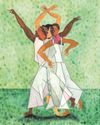
In September, Pope Francis became the first leader of the Catholic Church ever to visit Mongolia. It must have been a humbling stopover. The country has fewer than fifteen hundred Catholics. The welcoming ceremony, in Ulaanbaatar’s main square, attracted a few hundred spectators—a crowd less than a thousandth the size of one that had gathered to see him in Lisbon a month earlier. One of the attendees had come out to do his morning Tai Chi and unknowingly ended up at the event.
Not everyone understood why the Pontiff was there. A caterer at a banquet for the Vatican entourage asked a Times reporter, “What are Catholics again?” But the Pope came prepared. Speaking to diplomats, cultural leaders, and the Mongolian President, he celebrated the religious freedom protected under the Mongol Empire during the thirteenth and fourteenth centuries—“the remarkable ability of your ancestors to acknowledge the outstanding qualities of the peoples present in its immense territory and to put those qualities at the service of a common development.” He also celebrated “the Pax Mongolica,” the period of Mongol-enforced stability across Eurasia, citing its “absence of conflicts” and respect “of international laws.”
Denne historien er fra January 01 - 08, 2023 (Double Issue)-utgaven av The New Yorker.
Start din 7-dagers gratis prøveperiode på Magzter GOLD for å få tilgang til tusenvis av utvalgte premiumhistorier og 9000+ magasiner og aviser.
Allerede abonnent ? Logg på
Denne historien er fra January 01 - 08, 2023 (Double Issue)-utgaven av The New Yorker.
Start din 7-dagers gratis prøveperiode på Magzter GOLD for å få tilgang til tusenvis av utvalgte premiumhistorier og 9000+ magasiner og aviser.
Allerede abonnent? Logg på

ART OF STONE
\"The Brutalist.\"

MOMMA MIA
Audra McDonald triumphs in \"Gypsy\" on Broadway.

INTERNATIONAL AFFAIRS
\"Black Doves,\" on Netflix.

NATURE STUDIES
Kyle Abraham's “Dear Lord, Make Me Beautiful.”

WHAT GOOD IS MORALITY?
Ask not just where it came from but what it does for us

THE SPOTIFY SYNDROME
What is the world's largest music-streaming platform really costing us?

THE LEPER - LEE CHANGDONG
. . . to survive, to hang on, waiting for the new world to dawn, what can you do but become a leper nobody in the world would deign to touch? - From \"Windy Evening,\" by Kim Seong-dong.

YOU WON'T GET FREE OF IT
Alice Munro's partner sexually abused her daughter. The harm ran through the work and the family.

TALK SENSE
How much sway does our language have over our thinking?

TO THE DETECTIVE INVESTIGATING MY MURDER
Dear Detective, I'm not dead, but a lot of people can't stand me. What I mean is that breathing is not an activity they want me to keep doing. What I mean is, they want to knock me off. My days are numbered.